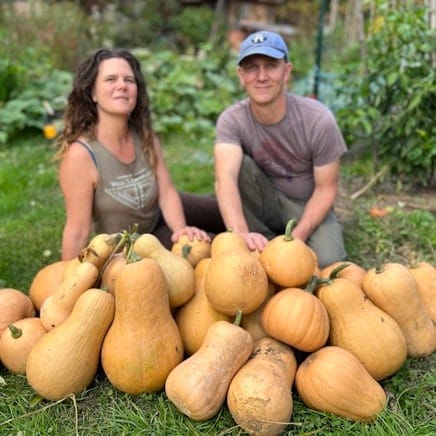On This Page
We welcome you to read through this page for a whole-picture perspective on the Gardening and Permaculture Apprenticeship. If you’re looking for specific information, you can use the following links to skip around:

Get your hands in the soil and your body in the rhythm of the seasons.
Becoming a permaculture apprentice will equip you with skills to nurture reciprocity with the web of life.
Join us for one day each week throughout the growing season (with an option to add on more hands-on time below) in the Wild Abundance gardens and orchards.
You’ll receive the experience of living and working with natural rhythms through in-depth tours, clear and hands-on guidance about what needs doing and when, and the practice (not just theory) of how to do it. The permaculture apprenticeship includes access to our comprehensive Online Gardening School, along with additional online instruction in permaculture. This way, you get to learn the concepts and put them into action, in a flexible online/in-person setting.
The permaculture and gardening apprenticeships meet for one 7-hour day each week during our nine-month growing season, from March 19 – November 19. If you have to miss a session or three, no worries. This program is designed for people who have real lives, so if you have a wedding to go to, a family trip, or a retreat that conflicts with the schedule, no problem!
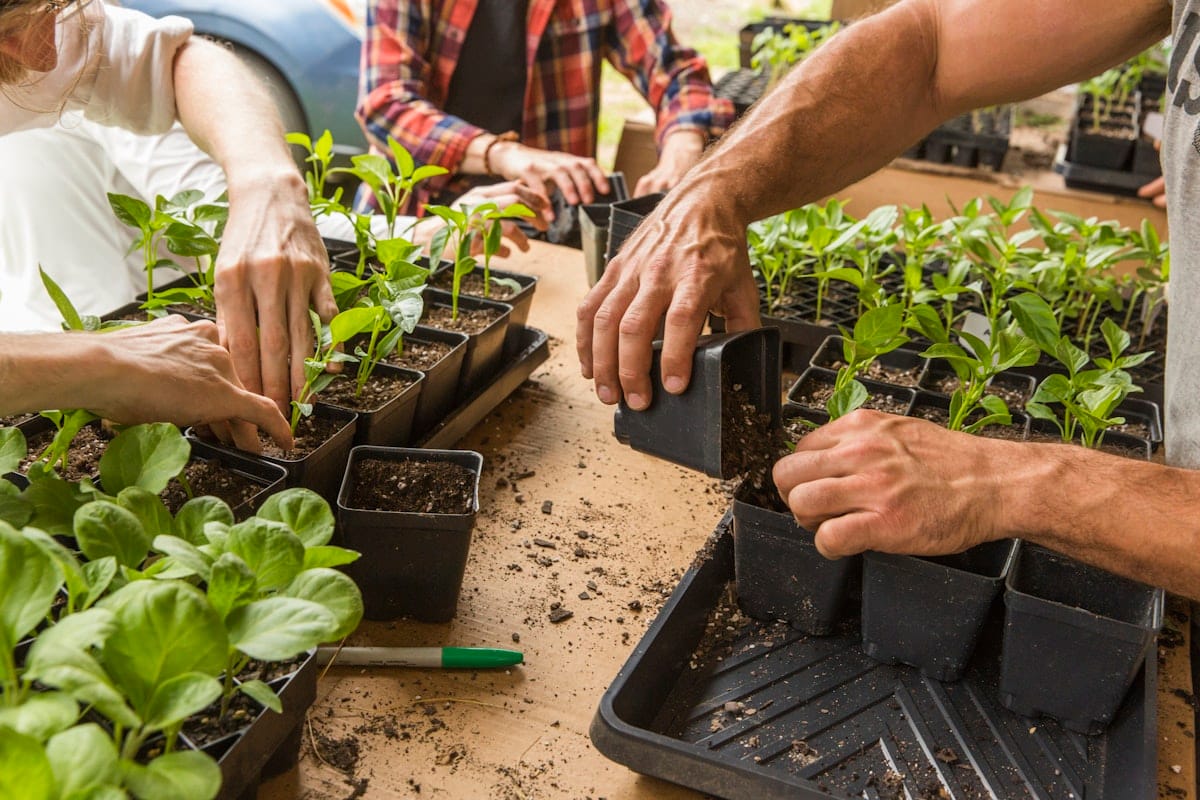
What Our Permaculture Apprentices Say
scroll right to read more

Genevive
Asheville, North Carolina
Small Business Owner
“I can think of no better way of learning to care for the soil, grow food, and be a better steward of my small piece of land than joining this apprenticeship. In class, we worked with the land for almost a year, following many annuals from seed to harvest and caring for the perennials. Gardening classes are easy to find, but there’s no substitute for hands in the soil in the same climate. I’m so fortunate to have found Wild Abundance!”

Margaret
Canton, North Carolina
Part-Time Public Health Program Coordinator & Stay-At-Home Mom
“It’s hard to capture in words just how amazing this long-term apprenticeship was and how grateful and fortunate I feel to have participated. It’s hard to find an in-person community these days, so I especially enjoyed the company!”
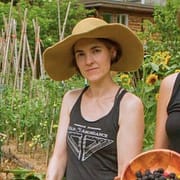
Rachel
“I liked the people so much—everybody, the students, the teachers, everything we did. I really enjoyed the personal aspect of it. I’m also grateful I got in! The class was full when I found it; thank goodness for the waitlist.””

Amy
“I’m so grateful for the people that I met and the relationships that I built. Good people all around. The environment is all outdoors and beautiful; it really highlights an alternative way of life. It is wonderful to see and it is deeply inspiring.”

Linda
Asheville, NC
Facilitator
“ It was such a pleasure to be in Wild Abundance’s outdoor space for the garden apprenticeship. Not only did I make friends, but I learned how to tend a garden from start to finish: from seed to soil, how to take care of it, how to winterize crops and save seeds for next year. I also learned how to tend perennial trees and berries. I’m coming out of it feeling confident that I can start many different garden projects on my own.”
What to Expect from the Permaculture Apprentice Program
Permaculture Plant Care and Organic Gardening
This season-long, one-day-a-week gardening and permaculture apprenticeship will give you a deep understanding of how to grow food in the Southern Appalachian bioregion; it’ll also give you a framework for doing so elsewhere. We’ll work in the well-established annual gardens and food-forest edges at the Wild Abundance campus.
Throughout our time together, you’ll get a chance to learn and do every step along the way for the full growing season. As a result, you’ll gather knowledge of sowing, tending, pruning, feeding, harvesting, and caring for dozens of annual and perennial food crops.
Ready to Join?
You’ll also receive our newsletters

Our permaculture apprenticeships are all about learning by doing.
Throughout the season, you’ll be guided by folks who have been growing in this area for a long while.
Tasks you’ll learn and do together include:
Annual Plant Care
- Bed preparation,
- Direct sowing seeds
- Growing transplants and transplanting
- Thinning and weeding annual crops
- Mulching, trellising, pest and disease management
- Planting and managing cover crops
- No-till techniques
- Season extension techniques
- Whatever else the garden calls for
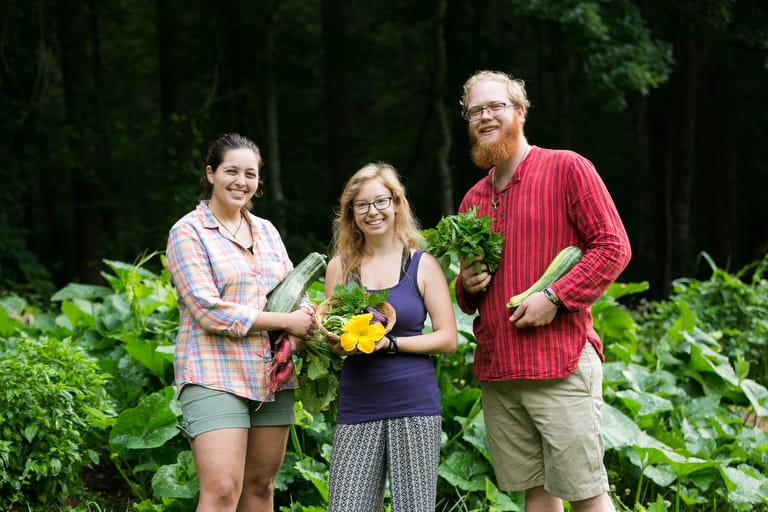
Perennial Plant Care
- Planting
- Pruning and shaping
- Weed control and mulching
- Troubleshooting diseases and pests
- Harvesting perennial crops like blueberries, raspberries, paw paws, asian pears, hardy citrus and chestnuts
- Plus whatever else comes up as the season unfolds!
Please note: the permaculture apprenticeships include real work. You’ll be bending, stooping, using tools, carrying heavy loads, pushing wheelbarrows on uneven ground, climbing ladders, and working in varied weather.
Nobody will be pushed beyond their own physical abilities, but everyone will be expected to “pull their own weight.” If there is a serious deluge, we will skip a week; however, we will gather and work in gentle rain, wind, and hot sun.
Before you apply, be sure that you’re up to the physical and mental challenge of working hard outside for a full day each week. If you have specific physical limitations, but still want to participate, reach out to us so we can discuss whether it’s a good fit.

Get into the rhythms of the seasons with our gardening apprenticeships!
Cultivating food in an ecological way is all about timing. Indeed, by working with the natural rhythms of the earth, we generally don’t even need to till the soil in an established garden. Through this program, you will come to understand the flow of the seasons in your bones, and get a feel for the right timing of all your food-producing activities.
Instead of learning by years of trial and error in your own garden, which is very heavy on time and money, you’ll have a chance to take a shortcut. You will be guided through study and hands-on practice by teachers who have been doing this stuff for decades. You’ll learn how to collaborate with ecological rhythms and produce some serious food.
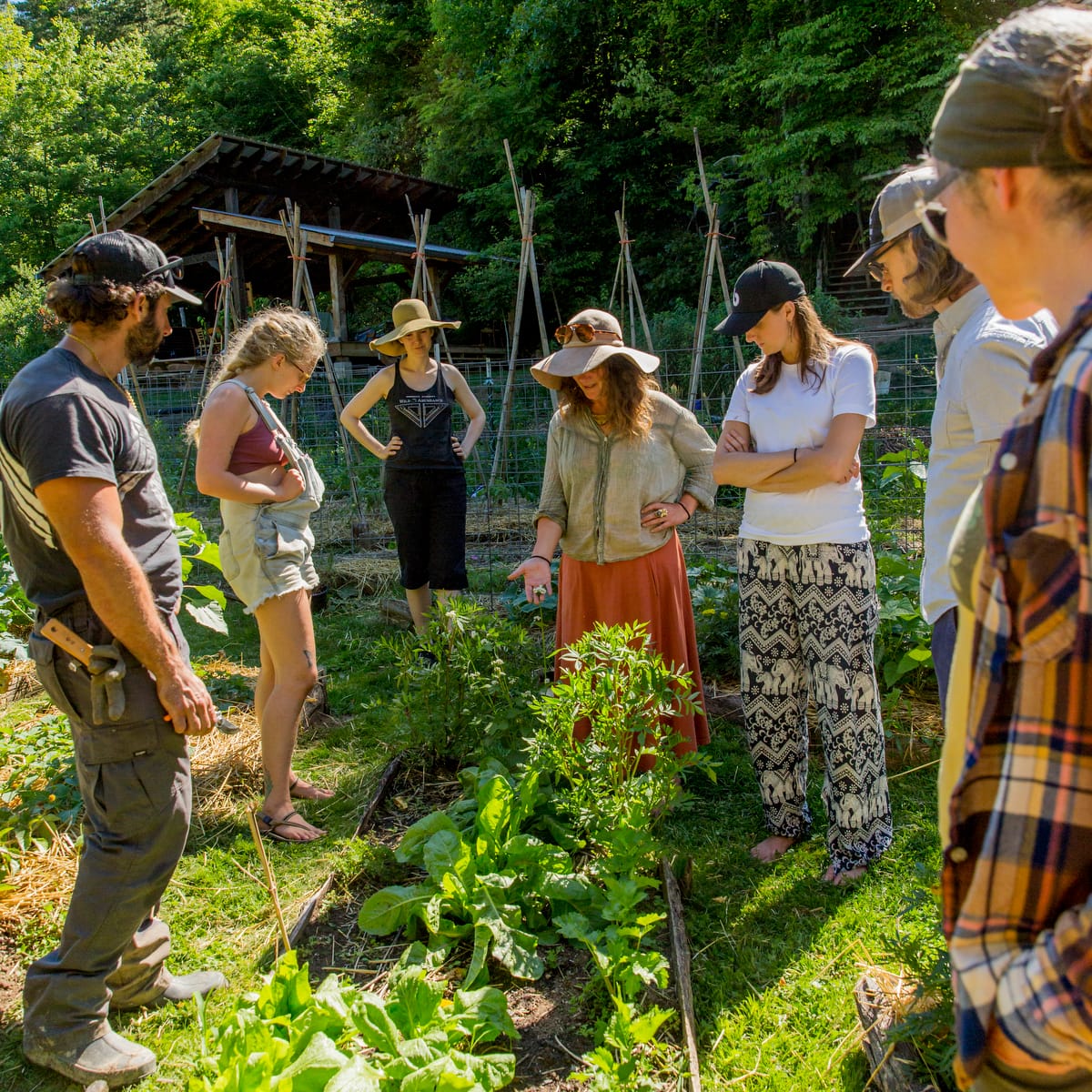
Special permaculture opportunities: A permaculture consultation for YOU!
During the summer months, we will escape the heat for a few of our perennial sessions to do garden and permaculture consultations for you, the permaculture apprentices. If you have a yard, garden, farm, or community garden plot, this is an opportunity to get advice and insights from your teachers and fellow students! Whether or not you have your own place to grow, these are awesome permaculture opportunities to shadow experienced permaculturalists giving consultations, as well as to try your hand at giving permaculture consultations yourself.
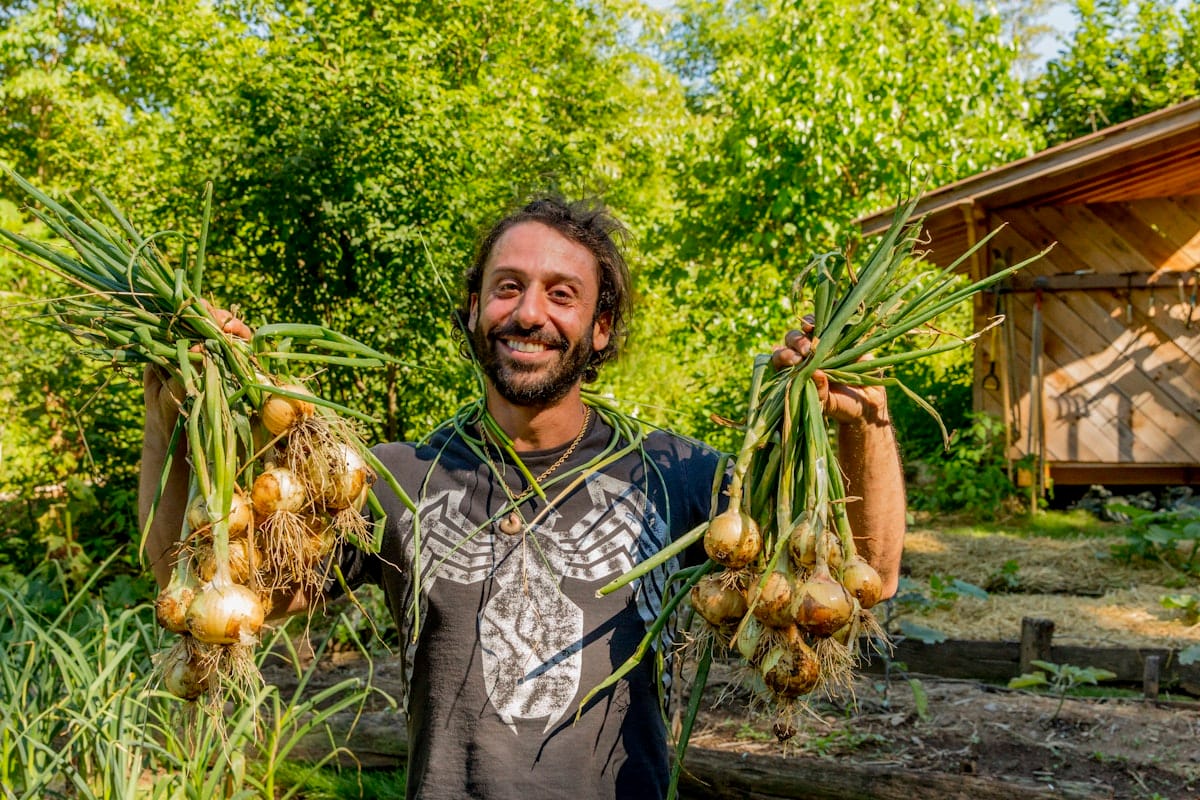
The Permaculture Apprenticeships Include:
- Weekly vegetable gardening instruction with hands-on learning and doing
- Weekly instruction and hands-on learning with perennial fruit and nut trees, as well as shrub planting, pruning, and care
- Unlimited access to the Wild Abundance Online Gardening School that you get to keep after the apprenticeship is over
- Special Permaculture Opportunities like field trips to forest gardens and harvesting from the wild
- Optional: Permaculture consultation by a lead instructor and fellow apprentices for your landscape or garden to check out what you have going on and give ideas on how to better reach your goals, whether they be around food production, beauty, or other desires.
Please note: this program does not include a weekly share of vegetables. During abundant times of year, apprentices will be sent home with veggies and fruits to enjoy, but food is not considered part of the program.
This program can stand-alone, or be a compliment to your at-home gardening and permaculture projects.
Over the years, we’ve seen that people learn gardening best when they’re able to tend their own plots at home (even tiny gardens made up of containers on a balcony), along with learning by our side. So, if you’ve got the space and inclination, we encourage you to plant some things at home, too, and apply your learning right away.
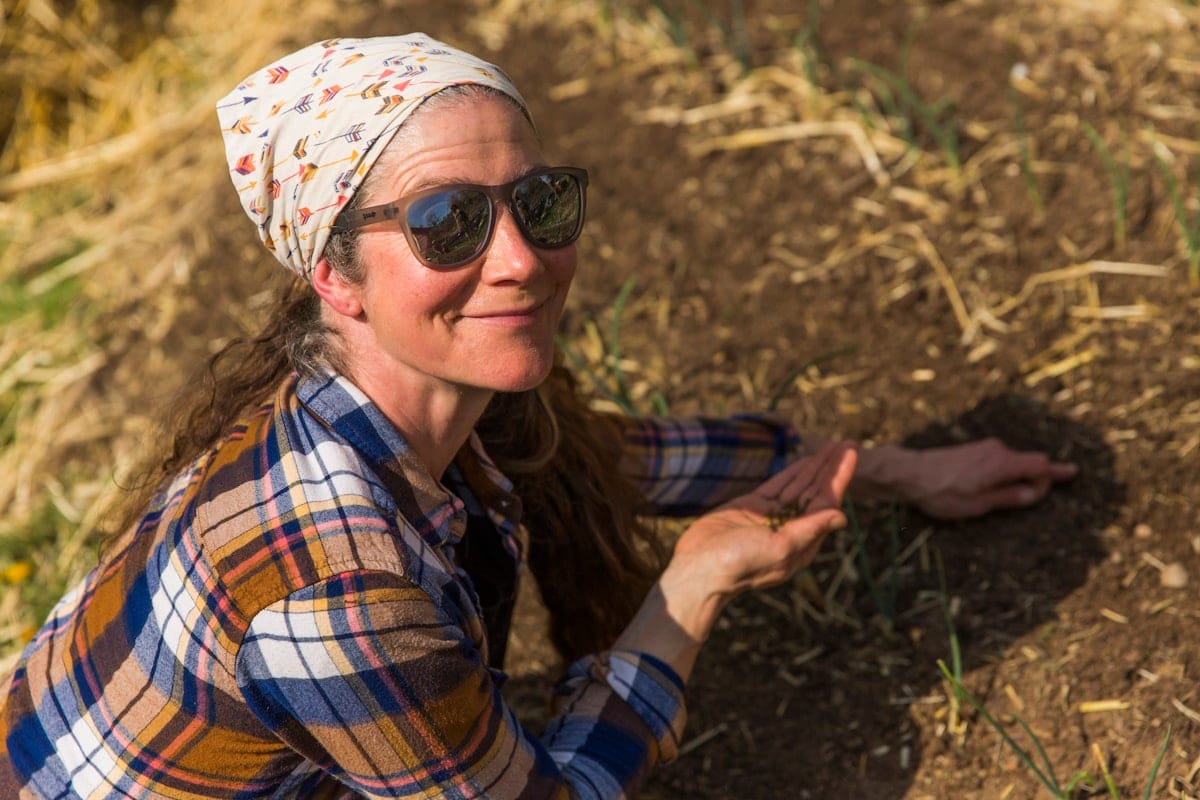
Online learning compliments in-person permaculture apprenticeship days.
The “lecture” aspect of this program is done totally online, through watching our online class materials. The in-person portion is completely hands-on, and you should expect to really get things done in the garden! You will be helping to tend fruit trees and bushes, and to grow vegetables.
Questions are welcome as we are getting our hands into the soil, in order to deepen and clarify the content that’s been shared online. We ask that every apprentice watch the assigned online portion of the program before the in-person days, so you can arrive with a baseline understanding of what we’ll be doing. This way, our discussions can be much richer and apprentices can utilize in-person time to deepen their knowledge.
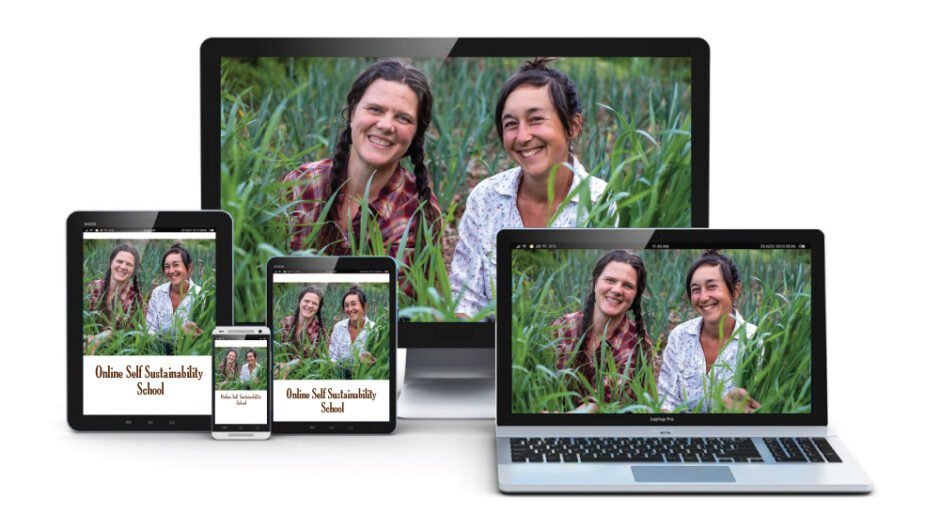
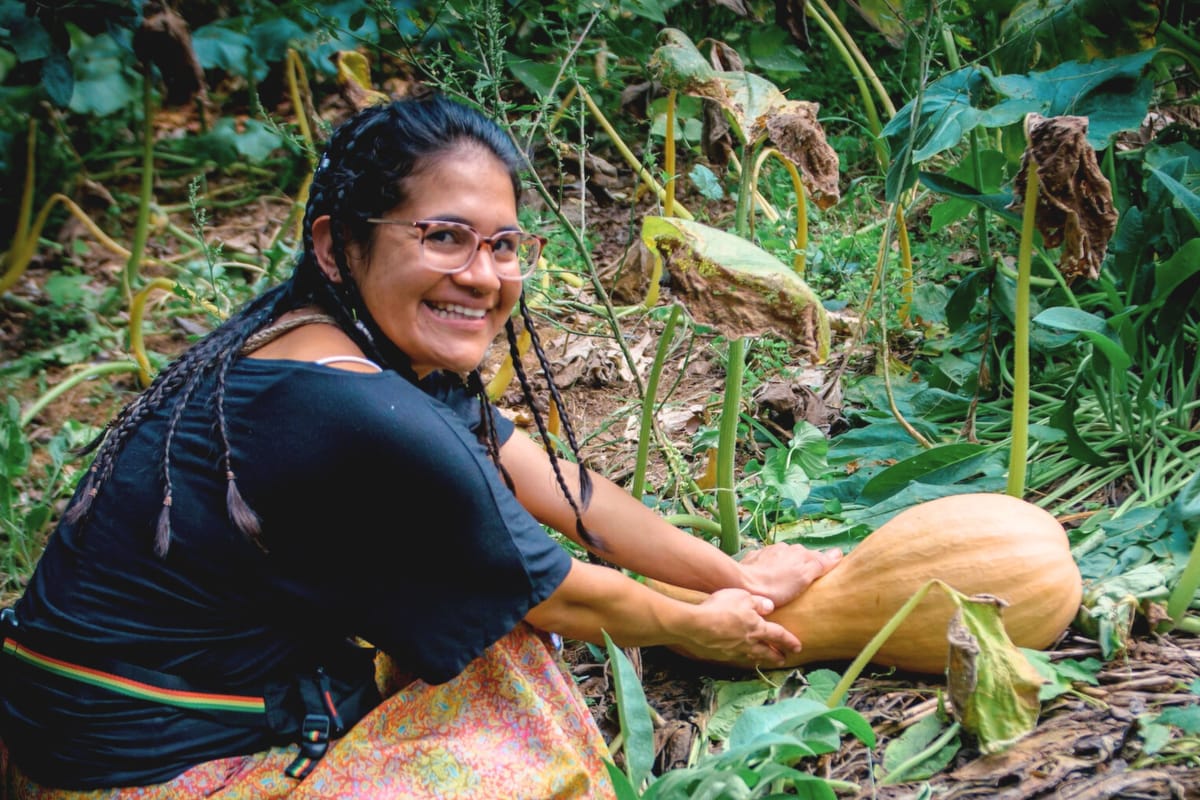
Schedule and Timing of the Permaculture & Gardening Apprenticeship
We generally meet each Tuesday, with some breaks and flexibility around weather, from March 19th to November 19. Within this time frame, three Tuesdays will be skipped for breaks, and we can expect that some days will be rained out. Approximately 29 of the 36 Tuesdays will be apprenticeship days.
Starting in March, we’ll meet from 9:30am-4:30pm to take maximum advantage of the sunshine on our east facing campus.
As the weather gets hot, we’ll change the timing to 12pm-7pm. This shift means we can do the sweaty work of annual gardening in the cooler early evening during midsummer.
As it cools down in the fall, we will return to the early spring timing (9:30-4:30), to make the most of the warm part of the day.
If you choose to include the design and installation intensive add-on, the class will meet from 9:30am-4:30pm on Mondays from August 4- November 17.
The vast majority of the days, we will focus on tending both perennials and annuals, but a few sessions will just be about perennials, and a few will just be focused on annual veggie gardens. If you have obligations that prevent you from coming for a few Tuesdays, don’t worry about it. Most students will miss a few days, but we expect you to attend at least three apprenticeship days per month, with exceptions made for extended trips.

Our typical permaculture apprenticeship days will have this general flow*:
- Arrive to Wild Abundance, ground, and check in with teacher and other students
- Tour of annual beds; observing what has changed, what the gardens need, , and what plants need to be planted at this juncture of the season
- Instruction on the things that need doing, and doing the things that need doing — with discussion and inquiry
- Lunch Break
- Settling in with a perennial planting: learning to identify the plants and the details of their care throughout the seasons
- Continued instruction and implementation in the gardens
And…. we like to mix it up
- We enjoy field trips during the perennials section of class for at least 5 sessions, mostly during the hottest part of the year to get out of the heat. Some field trips will be to the gardens or potential gardens of fellow students (more below), some will be to wild forests to observe plants and possibly dip in swimming holes, and some will be to established permaculture sites.
- You will occasionally learn food preservation techniques throughout the season (examples may be: making and canning tomato sauce, making kraut or kimchi, making pesto, pressing apples, etc)
- We will make medicine from plants in the permaculture landscape and from the wild.
*Subject to change due to weather and tasks at hand, we may tend to perennials before annuals.
Seasonal Activities in the Annual Garden and Food Forest
Following is a very generalized outline of what we will be doing throughout the seasons. These are broad brushstrokes, but know that you will take part in a great many of these activities and will have the opportunity to work with and learn the rhythms of dozens of species of fruits and vegetables — both common garden varieties and more unusual types.
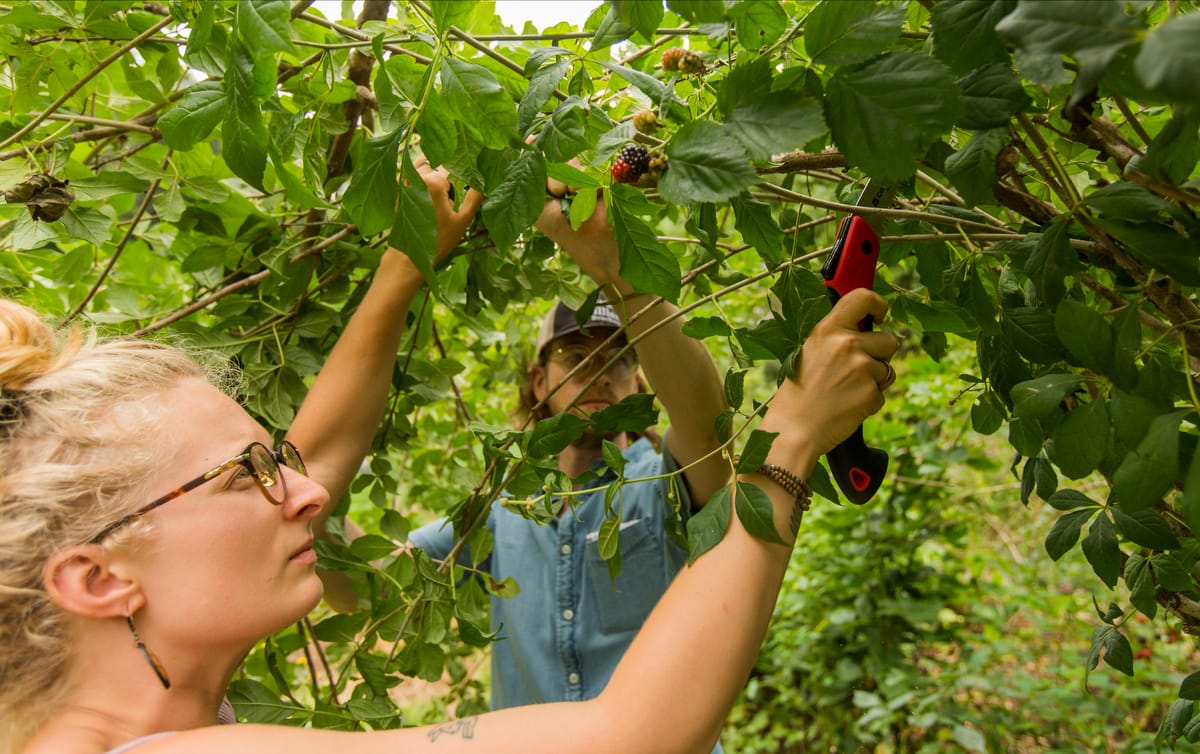
Spring
March: Prune and mulch trees to optimize production; plant berries and trees; start seeds in flats; cut some cover crops to prepare beds for spring planting, plant other cover crops; harvest weeds for eating
April: Prepare garden beds (no tilling or digging); plant out frost-hardy plants in garden; transplant up some vegetable starts into larger pots; weed recently sown beds; mulch and tend perennials
May: Plant out frost-sensitive plants; weed recently sown beds; mulch and tend perennials; start sweet potato slips; weed and mulch annuals and perennials; identify and squish bugs

Summer
June: Harvest berries; second planting of frost-hardy plants and cool-sensitive plants; build trellises; make and use plant-based “tea” fertilizers; weed and mulch annuals and perennials; squish bugs; harvest greens; prune suckers on fruit trees; shape fruit trees
July: Start seeds for late summer plantings; harvest berries and fruit; weed and mulch annuals and perennials; harvest vegetables
August: Plant crops for fall and winter harvests; harvest berries and fruit; weed and mulch annuals; prune berries; harvest lots of vegetables.

Fall
September: Continue to plant crops for fall and winter harvest; sow cover crops; harvest storage crops; weed and mulch
October: Winterize garden; harvest storage crops; put up hoops with row cover
November: Prune fruit trees and bushes; plant fruit and nut trees; plant overwinter root crops and bulbs
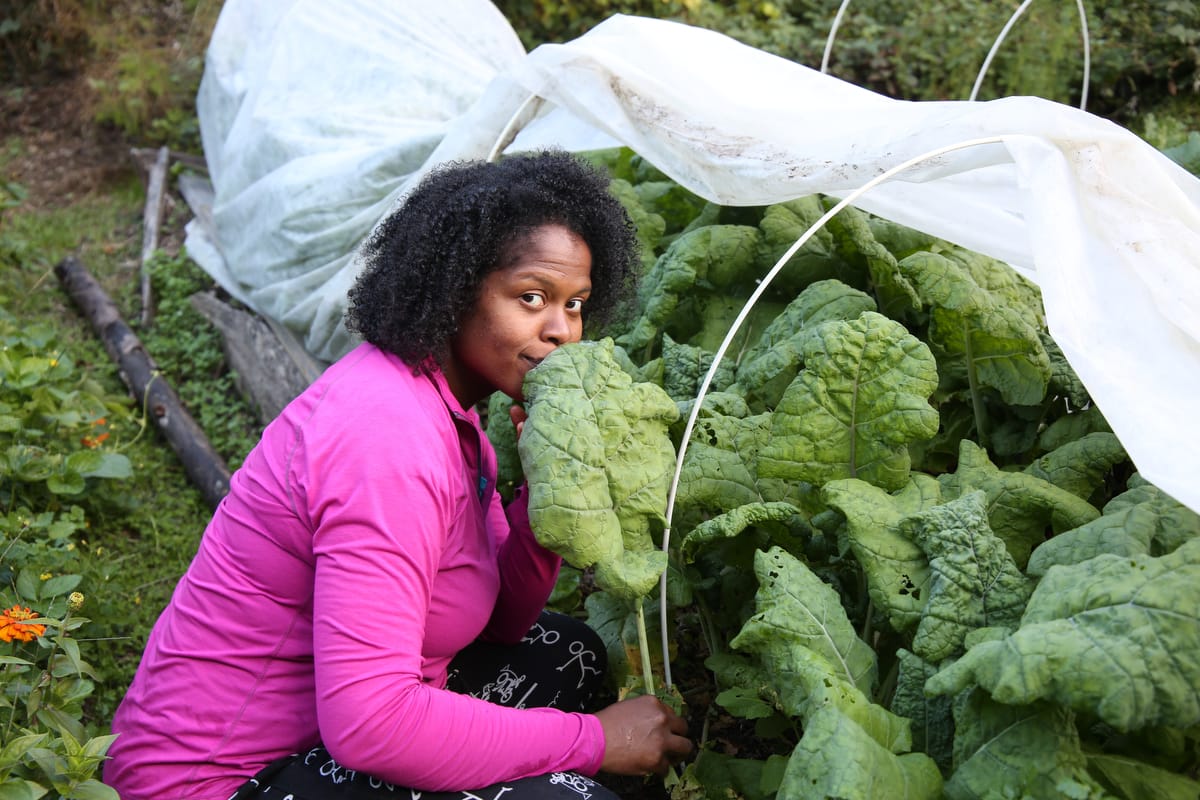
Permaculture Opportunity Add-On: Design & Installation Apprenticeship
This year we have a very special permaculture opportunity that students have the option to add onto the regular Gardening and Permaculture Apprentice Program. Permaculture design courses focus on creating designs, but it is outside of their scope to take these designs to the next step: plant sourcing and installation. This unique garden design apprenticeship add-on does just that.
The permaculture design and installation intensive will take place on Mondays from August 4 – November 17, and will be guided by an experienced permaculturalist who has been designing and creating permaculture landscapes for many years. You won’t find many permaculture opportunities like this!
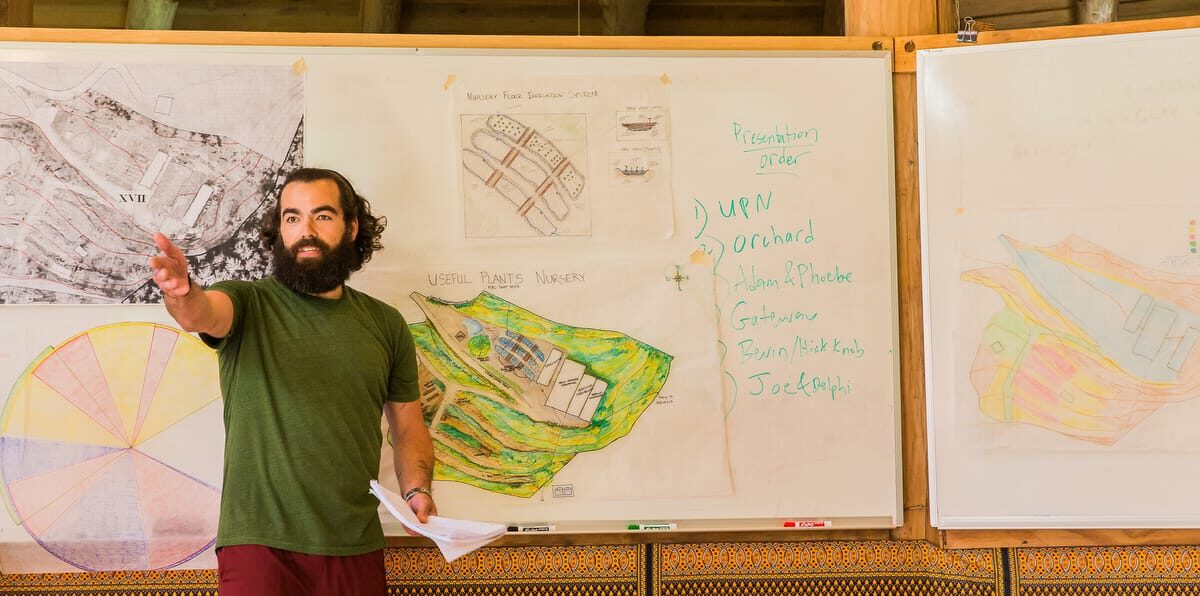
What You’ll Experience in the Permaculture Design Apprenticeship Add-On
- Collaborative design process with other students
- Site assessments
- Client interviews
- Designing for real world needs
- Learning the palette of permaculture landscape plants for this region
- Zone and sector planning
- Needs and yields analysis
- Old-school permaculture mapping
- Preparing a permaculture design presentation
- Feedback from teachers and students
- Design charette
Students will use a variety of design analysis tools to create a design with a design partner. They will present the design to the group for review and critique. The instructor will utilize a collaborative process to then create the final design, which will be executed by the group together.
Aug 4 to Nov 17
Plus you’ll learn important installation techniques, including:
- Soil assessment
- Soil remineralization
- Planting for microclimates
- Plant sourcing and selection
- Tree and shrub planting
- Ergonomic tool use to make planting more easeful
- Groundcovers: mulch and cover crops
Our group project will be designing the permaculture landscape for the new Wild Abundance Paint Fork Campus, which was purchased in 2022. Since then we have built an array of infrastructure, specifically designed for the classes that we hold. An extensive amount of earthmoving has been done with the student and staff experience in mind, including the installation of a pond as well as several terraced flat spots throughout the property.
The time has come to populate the landscape with the biological layer (plants). This back-drop and playground for the permaculture and garden design apprenticeship means that designers (you!) will get to help make your plans into reality, designing specifically for the school you are attending.
Student designs will be considered by the instructor, who will use a collaborative process to create the final design. This is a very special and rare opportunity in the field of permaculture education, and an important step in becoming a professional permaculture designer.
This unique permaculture opportunity is only available to folks who have registered for the Garden and Permaculture Apprenticeship now or in the past, or to folks who have earned their Permaculture Design Certificate through Wild Abundance or another program.
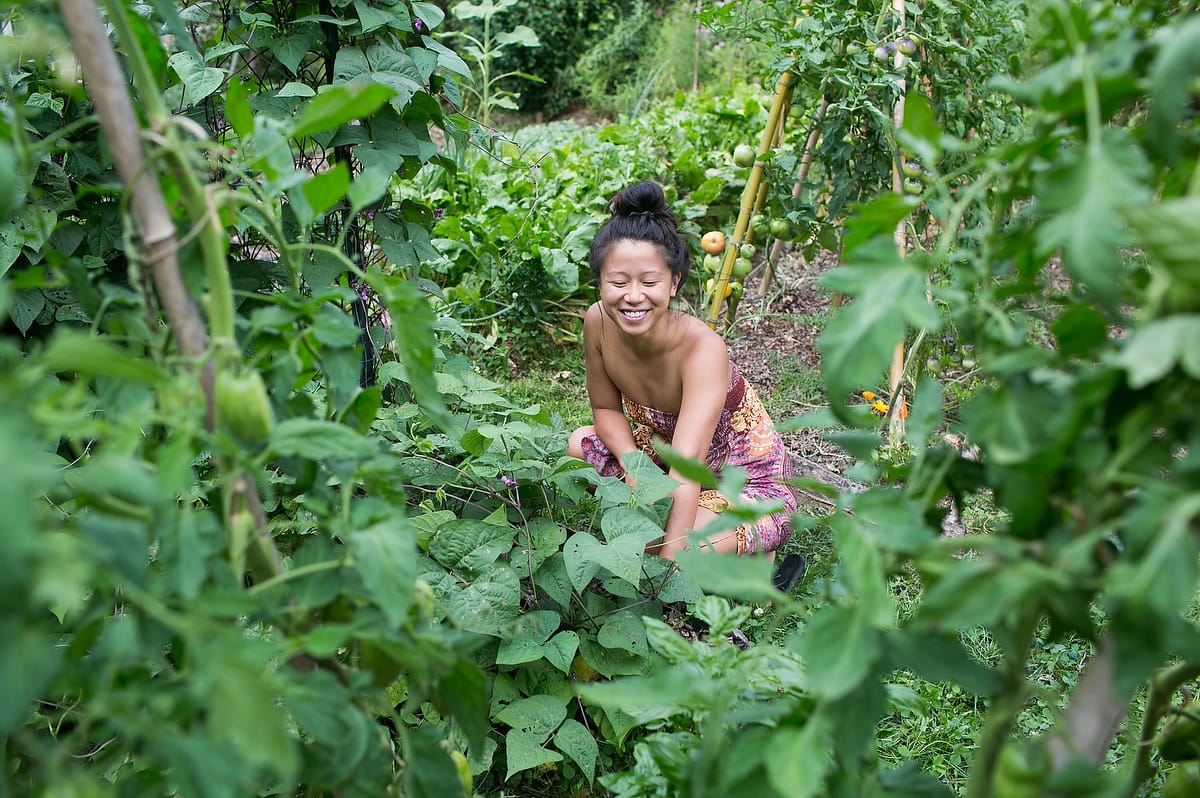
Group Size for Gardening and Permaculture Apprenticeship
We will be welcoming a maximum of 8 apprentices into our permaculture and gardening apprenticeship. If you are interested in these unique and specialized permaculture opportunities, please register as soon as possible.

Learn small-scale, non-mechanized food production
This class is about growing food on a human scale, without the use of machines; it’s not about commercial production. We will be tending the garden and food forests at the Wild Abundance campus (and possibly other nearby places), not working on a large farm. The skills that you learn here will be focused on growing a variety of foods for yourself, your family, and a small community. If your goal is to start a farm and grow food professionally, we suggest you find a farm-based apprenticeship program.

Frequently Asked Questions about the Permaculture & Gardening Apprenticeship
Permaculture is a system of ecological design and stewardship that weaves people together with their landscape. It places a large focus on sustainable food production and the creation of agricultural ecosystems that echo bioregional patterns. Permaculture also considers a whole-systems approach to living: shelter, energy, forestry, community, and gardening are all integrated into design planning.
Our permaculture apprenticeship focuses primarily on organic, permaculture-based gardening practices. Apprentices will learn how to tend a variety of annual garden crops as well as perennial herbs, berries, fruits, and nuts. Every step of the permaculture process will be discussed and practiced, including: soil and bed prep, sowing, planting, mulching, weeding, pest and disease management, pruning, harvesting, cover cropping, and more.
The apprenticeship takes place at a permaculture homesite and garden, so you will be immersed in permaculture-in-action. As a group, we’ll tour other permaculture sites and you’ll get to witness and participate in permaculture consultations that include a full spectrum of site design considerations. If you’re interested in delving deeper into site design and installation, you can register for our Garden Design & Permaculture Installation add-on, which meets on Mondays from August 4 – November 17.
Our permaculture apprentices will each have the opportunity to receive a permaculture consultation for their yard, garden, farm, etc. The consultation will be conducted by our instructors and weave in your hopes and visions for a permaculture paradise! Our students will be an active part of the consultation process.
If you don’t have a site of your own to work with, you will still greatly benefit from this process, as you will learn a lot about design for future projects. These permaculture opportunities are extremely valuable if you want to become a permaculture designer.
Instructors
Natalie Bogwalker
Chloe Lieberman
Scotty Greenheart
Dallas Conyers
Lewis Blake
The Permaculture & Gardening Apprenticeship is held near Asheville, NC, at the Wild Abundance Sanford Way Campus
Wild Abundance’s original home campus is on Sanford Way in Barnardsville, NC. It boasts many gorgeous and functional features, like a leaf-shaped organic permaculture garden, a food forest, a hand built log cabin, an open-air classroom topped with solar panels, and a stunning wattle and daub outdoor kitchen.
Please note: our campuses are all unconventional, with rustic amenities and uneven ground. Read more about Planning your trip and about our campuses. It takes about 25 minutes to get here from Asheville.
You’ve got several options of where to stay during your class. Some students camp, some locals commute, and others choose to rent accommodations with more creature comforts.
Onsite camping (with your own warm bedding and rainproof tent or hammock) is available for free to all students (including locals) during class. Some set-up-for-you tents are available with cots and cozy bedding for a flat fee.
Campers and all students have access to a lovely outdoor kitchen equipped with a stove and hot and cold water, plus pots and pans, knives and cutting boards, bowls, plates, and utensils, along with an outdoor shower with hot and cold running water and outhouse. If you’d rather rent a hotel, house or cottage, there are many available. We’ll share a curated list of nearby options once you’ve registered.
So you can better plan your trip to come learn with us, here’s some info on accommodations we offer, or that we link to in the student handbook you’ll receive upon registration. Below it you’ll find info on transportation.
- Camping with your own gear: free
- Staying in a large tent with a cozy cot and bedding that we set up for you: $200 flat fee; you can stay there anytime from 5pm before the first day of your class, to 12pm the day after your class ends.
- Hyper-local off-campus single rentals: $40-$2000/night + fees
- Hyper-local off-campus couples rentals: $20-100/person/night + fees
- Hyper-local off-campus group rentals: $25-$86/person/night + fees
Wild Abundance students are given awesome discounts at a local hotel, and a hyper-local inn. More information given in the student handbook upon registration.
Getting a place or renting a car with a group of fellow students and carpooling are great ways to make connections and reduce costs! We share contact info for each class so you can get in touch and make plans together. Everyone has a chance to keep their info private if they choose.
Our campus is about 25 minutes north of Asheville, 40 minutes from the Asheville Regional Airport, and 2.5 hours from the Charlotte International Airport. You’ll get detailed directions of how to get here upon registration.
You won’t need a car during your class. There’s a chance you may want to run an errand or go out to dinner with fellow students, and if this happens, it’s highly likely that another student with a car will be happy to give you a lift.
We’ve also got a list of folks who will do airport and grocery shuttle runs for $50-$80 each way. We share this information in the student handbook when you register. If you’d rather rent a car, those run anywhere from $45-$200/day. Just like with lodging, teaming up with a group of fellow students to share a car rental can help build connections and reduce costs.
Note: Our garden design and permaculture installation add-on students will be meeting at our beautiful Paint Fork Campus, which is just a few short miles from our Sanford Way Campus. We will send you additional information about Paint Fork when you register for the add-on.
Pricing Garden & Permaculture Apprenticeship & Design and Installation Add-on
Main Course: $2700-$5400*
Package (Main Course + Add-On): $4200-$8400*
Add-on only: $1500-$3000*
*Please pay what you can within this range. The median price helps cover the class costs. Choose the low end if you’re low income, or the maximum fee if your household earns over $115,000/year. Place yourself within this range based on your income.
